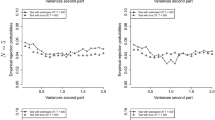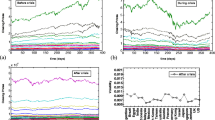Abstract
Inspired by the correlation matrix and based on the generalized Spearman’s \(\rho \) and Kendall’s \(\tau \) between random variables proposed in Lu et al. ( J Nonparametr Stat 30(4):860–883, 2018), \(\rho \)-matrix and \(\tau \)-matrix are suggested for multivariate data sets. The matrices are used to construct the \(\rho \)-measure and the \(\tau \)-measure among random vectors with statistical estimation and the asymptotic distributions under the null hypothesis of independence that produce the nonparametric tests of independence for multiple vectors. Simulation results demonstrate that the proposed tests are powerful under different grouping of the investigated random vector. An empirical application to detecting dependence of the closing price of a portfolio of stocks in NASDAQ also illustrates the applicability and effectiveness of our provided tests. Meanwhile, the corresponding measures are applied to characterize strength of interdependence of that portfolio of stocks during the recent two years.



Similar content being viewed by others
References
Belalia M, Bouezmarni T, Lemyre FC, Taamouti A (2017) Testing independence based on Bernstein empirical copula and copula density. J Nonparametr Stat 29(2):346–380
Ehrenberg ASC (1952) On sampling from a population of rankers. Biometrics 39(1/2):82–87
Escoufier Y (1973) Le traitement des variables vectorielles. Biometrics 29(4):751–760
Embrechts P, McNeil A, Straumann D (2002) Risk management: value at risk and beyond, Cambridge University Press, Ch. Correlation and dependency in risk management: properties and pitfalls, pp 176–223
Gábor JS, Maria LR, Nail KB (2007) Measureing and testing dependence by correlation of distance. Ann Stat 35(6):2769–2794
Grothe O, Schnieders J, Segers J (2014) Measuring association and dependence between random vectors. J Multivar Anal 123:96–110
Hotelling H (1936) Relations between two sets of variates. Biometrika 28:321–377
Hoeffding W (1948) A class of statistics with asymptotically normal distribution. Ann Math Stat 19(3):293–325
Hays WL (1960) A note on average tau as a measure of concordance. J Am Stat Assoc 55:331–341
Joe H (1997) Multivariative models and dependence concepts. Springer, Dordrecht
Joel O, Ramon R (1983) On the class of elliptical distributions and their applications to the theory of portfolio choice. Journal of Finance 38:745–752
Kendall MG (1938) A new measure of rank correlation. Biometrika 30(1/2):81–93
Kendall MG (1970) Rank correlation methods, 4th edn. Griffin, London, pp 148–154
Kendall MG, Smith BB (1939) The problem of \(m\) rankings. Ann Math Stat 10(3):275–287
Koroljuk VS, Borovskich YV (1994) Theory of u-statistics, chapter 4. Springer, New York
Kojadinovic I, Holmes M (2009) Tests of independence among continuous random vectors based on Cramér-von Mises functionals of the empirical copula process. J Multivar Anal 100:1137–1154
Lu DW, Zhang LY, Wang XG, Song LX (2018) Some new measures of dependence based on Spearman’s \(\rho \) and Kendall’s \(\tau \). J Nonparametr Stat 30(4):860–883
Marozzi M (2014) Testing for concordance between several criteria. J Stat Comput Simul 84(9):1843–1850
Marozzi M (2016) Multivariate tests based on interpoint distances with application to magnetic resonance imaging. Stat Methods Med Res 25:2593–2610
Maache HE, Lepage Y (2003) Spearman’s rho and Kendall’s tau for multivatiate data sets. Mathematical statistics and applications: Festischrift and Constance van Eeden. Lecture notes-monograph series, Institute of Mathematical Statistics, pp 113–130
Nelsen RB (2006) An introduction to copula, 2nd edn. Springer, New York
Pesarin F (2001) Multivariate permutation tests with applications in biostatistics. Wiley, Chichester
Pesarin F, Salmaso L (2010) Permutation tests for complex data (theory, application and software). Wiley, Chichester
Pollet JM, Wilson M (2010) Average correlation and stock market returns. J Financ Econ 96:364–380
Quessy J-F (2009) Theoretical efficiency comparisons of independence test based on multivariate versions of Spearman’s rho. Metrika 70:315–338
Quessy J-F (2010) Applications and asymptotic power of marginal-free tests of stochastic vectorial independence. J Stat Plan Inference 140:3058–3075
Robert P, Escoufier Y (1976) A unifying tool for linear multivariate statistical methods: the rv-coefficient. Appl Stat 25(3):257–265
Schmid F, Schmidt R (2007) Multivariate extensions of Spearman’s rho and related statistics. Stat Probab Lett 77(4):407–416
Spearman C (1904) The proof and measurement of association between two things. Am J Psychol 15(1):72–101
Székely G, Rizzo M (2007) Measuring and testing dependence by correlation of distance. Ann Stat 35(6):2769–2794
Székely G, Rizzo M (2009) Browian distance covariance. Ann Appl Stat 3(4):1236–1265
Santi T, Sompong D (2016) Measures of the functional dependence of random vectors. Int J Approx Reason 68:15–26
Wlodzimierz W (2015) Kendall’s tau and Spearmam’s rho for \(n\)-dimensional Archimedean copulas and their asymptotic properties. J Nonparametr Stat 27(4):442–459
Zhang LY, Lu DW, Wang XG (2019) The essential dependence for a group of random vectors. Communications in statistics—theory and methods submitted
Zinoviy L, Udi M, Tong S (2018) A multivariate til covariance measure for elliptical distributions. Insur Math Econ 81:27–35
Acknowledgements
The research of the first author is sponsored by the China Scholarship Council. The second author is supported by the National Natural Sciences Foundation of China (Grant No. 11571058), the Fundamental Research Funds for the Central Universities (Grant No. DUT18LK18), the Dalian High Level Talent Innovation Programme(Grant No. 2015R051) and the High-level innovative and entrepreneurial talents support plan in Dalian (Grant No. 2017RQ041). The third author is supported by the National Natural Sciences Foundation of China (Grant No. 11471065).
Author information
Authors and Affiliations
Corresponding author
Additional information
Publisher's Note
Springer Nature remains neutral with regard to jurisdictional claims in published maps and institutional affiliations.
Proof of Proposition 1
Proof of Proposition 1
From (5), (8), for the couple \(X_{k,r},X_{l,s}\), \(k\ne l,r\in \{1,2,\ldots ,d_{k}\},s\in \{1,2,\ldots ,d_{l}\}\), the estimators of \(\rho (X_{k,r},X_{l,s})\) and \(\tau (X_{k,r},X_{l,s})\) by U-statistic are
where
are the symmetric kernels of \(\rho (X_{k,r},X_{l,s})\) and \(\tau (X_{k,r},X_{l,s})\). Under the null hypothesis that \(\varvec{X}^{(k)}\) and \(\varvec{X}^{(l)},~k\ne l\) are independent,
then
where \(\xi \) is \(\rho \) or \(\tau \). By Hoeffding (1948)’s decomposition theorem, we find
Let \(W_{\rho (X_{k,r},X_{l,s}),n}=\frac{3}{\sqrt{n}}\sum _{i=1}^{n} h_{\rho (X_{k,r},X_{l,s}),1}^{*}(X_{k,r,i},X_{l,s,i})\). Then
Consider \(E\left( h_{\rho (X_{k,r},X_{l,s})}^{*}\left( (X_{k,r,i},X_{l,s,i}),(X_{k,r,j},X_{l,s,j}), (X_{k,r,t},X_{l,s,t})\right) \right. \left. h_{\rho (X_{k,r},X_{l,s}),1}^{*}(X_{k,r,i},X_{l,s,i})\right) \), where \(1\le i<j<t\le n\). If \(i=1\), from (13), for \(\forall ~2\le j<t\le n\), we have
If \(i>1\), then
Thus,
Since \(\displaystyle \lim _{n\rightarrow \infty }Var(\sqrt{n}\hat{\rho }_{n}(X_{k,r},X_{l,s}))=Var(W_{\rho (X_{k,r},X_{l,s}),c})=1\), for \(\forall ~c\ge 1\), combining (14)–(17), it is easy to see
Let \(W_{\tau (X_{k,r},X_{l,s}),n}=\frac{2}{\sqrt{n}}\sum _{i=1}^{n}h_{\tau (X_{k,r},X_{l,s}),1}^{*}(X_{k,r,i},X_{l,s,i})\). According to the above procedure, we have
Using (18) and (19), for any \(X_{k,r}\) from \(\varvec{X}^{(k)}\), \(X_{l,s}\) from \(\varvec{X}^{(l)}\), \(X_{a,\alpha }\) from \(\varvec{X}^{(a)}\), and \(X_{b,\beta }\) from \(\varvec{X}^{(b)}\), \(k\ne l,~a\ne b\), we have
where \(\xi \) denotes \(\rho \) or \(\tau \). Denote two \(\sum _{k=1}^{m-1}\sum _{l=k+1}^{m}d_{k}d_{l}\)-column vectors as
where \(\varvec{\Lambda }_{\xi (\varvec{X}^{(k)},\varvec{X}^{(l)}),n}= \begin{pmatrix} \hat{\xi }_{n}(X_{k,1},X_{l,1})\\ \hat{\xi }_{n}(X_{k,1},X_{l,2})\\ \vdots \\ \hat{\xi }_{n}(X_{k,1},X_{l,d_{l}})\\ \hat{\xi }_{n}(X_{k,2},X_{l,1})\\ \vdots \\ \hat{\xi }_{n}(X_{k,2},X_{l,d_{l}})\\ \vdots \\ \hat{\xi }_{n}(X_{k,d_{k}},X_{l,d_{l}}) \end{pmatrix},~ \varvec{W}_{\xi (\varvec{X}^{(k)},\varvec{X}^{(l)}),n}= \begin{pmatrix} W_{\xi (X_{k,1},X_{l,1}),n}\\ W_{\xi (X_{k,1},X_{l,2}),n}\\ \vdots \\ W_{\xi (X_{k,1},X_{l,d_{l}}),n}\\ W_{\xi (X_{k,2},X_{l,1}),n}\\ \vdots \\ W_{\xi (X_{k,2},X_{l,d_{l}}),n}\\ \vdots \\ W_{\xi (X_{k,d_{k}},X_{l,d_{l}}),n} \end{pmatrix}\) are \(d_{k}d_{l}\)-vectors, \(1\le k<l\le m\) and \(\xi \) represents \(\rho \) or \(\tau \). From (18) and (19), it is proved that \(\sqrt{n}\varvec{\Lambda }_{\xi (\varvec{X}^{(1)},\ldots ,\varvec{X}^{(m)}),n}\) and \(\varvec{W}_{\xi (\varvec{X}^{(k)},\varvec{X}^{(l)}),n}\) have the same limit distribution. Combining (13) and multidimensional CLT, as \(n\rightarrow \infty \), we have
where
is a symmetric and positive definite matrix of dimension \(\left( \sum _{1\le k<l\le m}d_{k}d_{l}\right) \times \left( \sum _{1\le k<l\le m}d_{k}d_{l}\right) \), and for any \(1\le k<l\le m\), \(1\le a<b\le m\), \(r\in \{1,\ldots ,d_{k}\}\), \(s\in \{1,\ldots ,d_{l}\}\), \(\alpha \in \{1,\ldots ,d_{a}\}\) and \(\beta \in \{1,\ldots ,d_{b}\}\), the \((\sum _{\mu =1}^{k-1}\sum _{\nu =\mu +1}^{m}d_{\mu }d_{\nu } +d_{k}\sum _{\nu =k+1}^{l-1}d_{\nu }+(r-1)d_{l}+s,\sum _{\mu =1}^{a-1} \sum _{\nu =\mu +1}^{m}d_{\mu }d_{\nu }+d_{a}\sum _{\nu =a+1}^{b-1}d_{\nu }+ (\alpha -1)d_{b}+\beta )\) entry of \(\varvec{\Sigma }\) is
where \(U_{k,r,i}=F_{k,r}(X_{k,r,i})\). Note that \(\rho _{s}(X_{k,r,i},X_{a,\alpha ,i})\rho _{s}(X_{l,s,i},X_{b,\beta ,i})=0\) unless \(k=a,l=b\). Especially, the entries of \(\varvec{\Sigma }\) on the principal diagonal are 1. Hence, as \(n\rightarrow \infty \),
Let \(\varvec{I}_{\sum _{1\le k<l\le m}d_{k}d_{l}}=(1,1,\ldots ,1)^{\top }\) be a vector of dimension \(\sum _{1\le k<l\le m}d_{k}d_{l}\). Rewrite
Since
we note that the third equality holds since (21) in which \(\varvec{\Sigma }\) has \(\varvec{\Sigma }_{i},i=1,\ldots ,\frac{m(m-1)}{2}\) down the principal diagonal and zeros elsewhere, and the results follow from (22)–(24).
Rights and permissions
About this article
Cite this article
Zhang, L., Lu, D. & Wang, X. Measuring and testing interdependence among random vectors based on Spearman’s \(\rho \) and Kendall’s \(\tau \). Comput Stat 35, 1685–1713 (2020). https://doi.org/10.1007/s00180-020-00973-5
Received:
Accepted:
Published:
Issue Date:
DOI: https://doi.org/10.1007/s00180-020-00973-5




